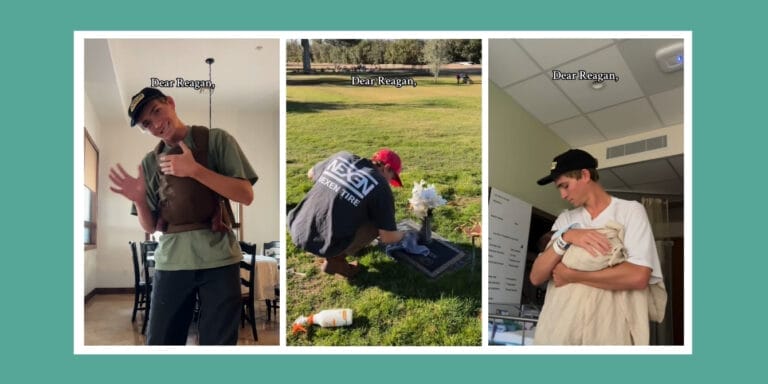This 9-year-old’s first words to his foster baby brother will stay with you

Credit: Tiktok/@l_garciaaa01
“It was a Sunday and he wanted to stay in his Sunday best, suit and tie, to meet his newborn foster baby brother,” Garcia said.
Table of Contents
Luz Garcia and her husband have been fostering children since 2018. But nothing could have prepared her for the moment her son, 9-year-old Xeius, met his newborn foster baby brother, Benny— a bond that would end up reshaping their family forever.
In a TikTok that has now been viewed over 3 million times, Garcia captured the instant connection between the brothers. She told Newsweek that Xeius’s first interaction with Benny was one she’ll never forget.
“It was a Sunday and he wanted to stay in his Sunday best, suit and tie, to meet his newborn foster baby brother,” Garcia said. At the time, no one knew Benny would be staying forever. Xeius, who had been asking for a baby brother for years, was “beyond excited.”
Related: Big sister tries to help dress baby brother—what happens is pure two under two chaos
When he finally got to hold Benny, Xeius made a promise: to protect him and to love him.
“It was the sweetest and saddest thing to watch, because we were told that a relative would be getting approved soon,” Garcia explained.
The viral clip shows the emotional weight of fostering. In one heartbreaking moment, Xeius cries for Benny—apologizing that his biological family couldn’t care for him, while promising that he would.
Commenters flooded the video with love and recognition. One person wrote, “It’s family like yours that put my heart at ease when my sister was in the system. She had an amazing family looking after her and I was able to get my life together and then became her foster parent because my mom couldn’t be present. I’m 24 she is two.”
Another added, “This is such a testament to how you’ve raised [Xeius]. He’s emotionally intelligent, acutely aware of his heart and his home within it, fiercely loyal to those he chooses as his and proud to be a shepherd of love.”
A family is chosen
Garcia explained that her family is generally pro-reunification with biological parents, since that is the foster care system’s primary goal. But in this case, after all family options were explored and exhausted, the Garcias were asked if they would be open to adoption.
“It was an immediate yes,” Garcia said.
Since finalizing Benny’s adoption in December 2024, their bond has only grown stronger.
“They are truly each other’s safe place,” Garcia shared. “They laugh together and Xeius encourages and protects Benny like no other. There’s such a strong foundation of love and security between them.”
And for Garcia, the experience reframed her understanding of family.
“This experience has taught us that family is not created by blood or DNA,” she said. “Family is chosen—it’s the love and safety you choose to give. Fostering has shown me how resilient children are, how deep love can grow in such a short time and how important it is to open your heart even when it might hurt.”
She added, “Love doesn’t run out. The more you give, the more it grows. And family can be built in so many beautiful ways.”
Related: The way this 9-year-old carries his baby brother? We weren’t ready
Supporting kids through fostering and adoption
Stories like Xeius and Benny’s highlight the love that can grow in foster families—but also the challenges. Parents who foster or adopt know that children, especially siblings, carry enormous feelings about transitions.
Here are a few ways experts recommend supporting kids through the ups and downs of foster care:
1. Explain the process in age-appropriate ways
Professionals recommend tailoring information to a child’s developmental stage. For younger children, keep explanations simple and reassuring—picture books like Maybe Days introduce foster care in child-friendly terms. For older children, it’s appropriate to add more detail about roles, reunification, and adoption.
2. Validate big emotions through routines and comfort rituals
Children in foster care may experience grief, excitement, or both at once. Experts emphasise sitting with those feelings rather than trying to erase them, while using memory books, goodbye letters, or predictable routines to help them feel grounded and safe. These structured rituals build trust and give children tools to cope with transitions.
3. Encourage sibling bonds without shifting kids into parent mode
Research shows siblings placed together provide one another with familiarity, comfort, and a sense of stability—leading to better long-term outcomes in foster care. Foster families are encouraged to nurture sibling bonds with “helper roles” that empower older children, while still making space for one-on-one time so each child feels valued as an individual.
4. Model respect and empathy for biological families
Even when separation stems from neglect or trauma, experts urge foster carers to show compassion for birth parents. Respectful language and small gestures—like asking for their input on the child’s needs—help children hold both truths: that they can love their foster family while still respecting their roots. Co-parenting approaches, where safe, also reduce stress for children and ease transitions.
5. Protect children’s privacy online
Most agencies prohibit posting identifiable photos or details of foster children until adoption is legally finalised. Even then, adoption experts caution that oversharing may put a child’s privacy or safety at risk. Foster carers are advised to use private sharing methods and avoid revealing names, locations, or faces in public posts.
For parents considering fostering, Garcia’s story is a reminder of what’s possible when you open your heart: resilience, unconditional love, and siblings who truly choose each other.
Source:
- Celia Center. 2021. “How to Explain Foster Care to a Child? What is Foster Care? Animation created by Jeanette Yoffe, Former Foster Youth-Adoptee.”
- The Forgotten Initiative. 2020. “Saying Goodbye: Navigating Reunification as a Foster Parent.”
- Casey Family Programs. 2020. “How are child protection agencies promoting and supporting joint sibling placements and adoptions?”
- Creating a Family. “Co-Parenting in Foster Care-How to Establish a Relationship with Birth Parents.”
- Intercept Health. 2022. “Social Media and Foster Parenting: Protecting Foster Children’s Privacy.”





































